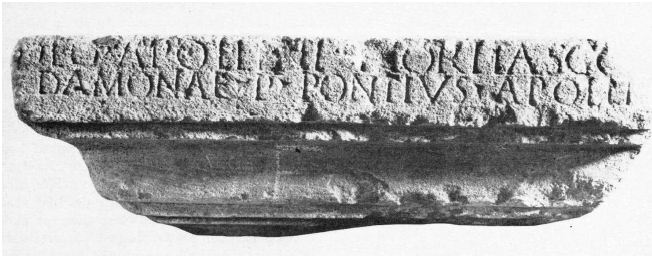d) Alise-Sainte-Reine (Côte d’Or)
In Alise-Sainte-Reine, Damona is partnered with the god Moristasgus in an inscription discovered by Joël Le Gall in 1962 during excavations in the cemetery of Saint-Père situated on Mont-Auxois.2061 The dedication is engraved on the corner of a big cornice or on the pedestal of a statue: Deo Apollini Moritasgo [et] Damonae P(ublius) Pontius Apolli[naris], ‘To the god Apollo Moritasgus and to Damona, Publius Pontis Apollinaris (had this monument erected)’ (fig. 46).2062 The dedicator bears Latin names and is a Roman citizen.
Moritasgus is known from three other inscriptions discovered at a water sanctuary excavated at the eastern part of Mont-Auxois, above a cross called the ‘Croix-Saint-Charles’.2063 Olmsted relates the first part of his name to a root *mori- meaning ‘sea’ and the second part tasgo- to an Indo-European root *sāg- signifying ‘to tend toward’, ‘to seek’.2064 According to him, Moritasgus would thus be ‘the One approaching the Sea’ or ‘the Sea-Seeking One’. As for Delamarre, he suggests that his name is composed of Gaulish mori, ‘sea’ and tasgos, ‘badger’ and means ‘Badger of the Sea’.2065 The source sanctuary dedicated to Moritasgus was composed of a hexagonal temple, surrounded by a portico, where votive offerings, such as coins and wheels in bronze of different sizes, were discovered; two small square and hexagonal chapels; a basin in wood; a small swimming-pool; and important thermal buildings, consisting of two primitive rooms with heated and cold swimming-pools, two other rooms and a huge portico, which were erected on top of previous Gaulish installations.2066 The sacred waters were harnessed by a network of pipes supplying all the buildings of the sanctuary. The belief in the healing power of the local waters is attested by the numerous anatomic ex-votos* representing heads, legs, busts, breasts, fingers, male and female genital organs, eyes and swaddled children. The waters have no therapeutic properties today, but analyses carried out in 1899 revealed that they had medicinal virtues in ancient times.2067

In the small 2nd-century AD square chapel of Moristasgus’s sanctuary, the head and the left hand of a female statue in white limestone were discovered in a central square basin, which was supplied by a spring.2068 The head is framed by abundant and wavy hair and is retained by a headband made of ears of corn, symbolizing fertility, while the hand holds a snake, a possible emblem of healing through water.2069 Originally, the statue was polychromous: the body was painted in white, the hair in red, the diadem in green and the ears of corn in yellow. In view of the inscription to Moritasgus and Damona, Le Gall assumes that the statue is a figuration of Damona and that the chapel was dedicated to her. No archaeological evidence has been uncovered so far to support this theory: the inscription was not discovered in the chapel and the statue is anepigraphic.